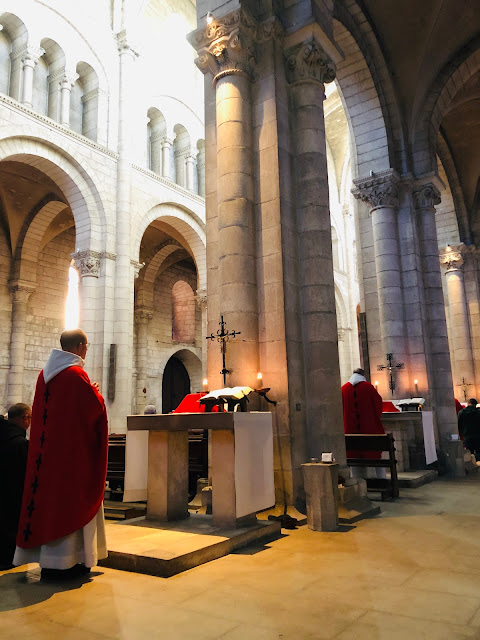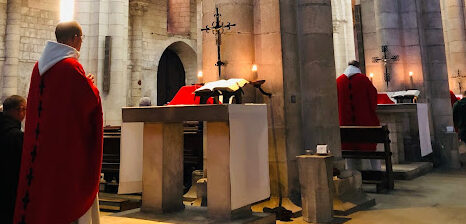p/c Notre-Dame De Fontgombault
Several years ago, as I was switching from the new sacraments to the ancient Roman sacraments, I stopped at a parish in Tampa one afternoon. I asked the parish secretary if I could offer Holy Mass there. She asked who was going to attend my Mass. I said I was alone. She looked bewildered. No youth group? No family of origin traveling with you? The parish secretary only thought of the Mass in anthropocentric terms: If no one was there to receive Holy Communion, why would this priest show up at her parish and try to offer Mass alone? It was as crazy to this lady as if a layman had showed up asking for marriage prep to marry himself. Alas, the poor lady did not understand that the Holy Mass is God the Son offering Himself up in an immolation of love to God the Father, regardless of how many people on earth were in attendance (provided there be one validly ordained priest.) As you probably know, every Mass has trillions of angels and millions of saints attending the Holy Sacrifice, even if the priest be the only one to receive Holy Communion.
But most modernist Catholics only know about the visible parts of the Mass, and the Novus Ordo at that. (The above discussion ended before there was any discussion on the TLM. She just couldn’t fathom a priest offering any Mass alone.)
But there is also a modern-myth plaguing certain traditionalist Catholics today that insists a priest may not offer his low Mass daily unless he have an acolyte (altar server.) Even though this myth is wrong, there’s some good reasons why a few traditionalists have come to this erroneous conclusion.
The first reason is that the Solemn High Mass is the norm to the Roman Rite as I explained here. Thus, the low Mass (Mass without singing) was always concessionary (Plan B) through the Catholic Church history of the first millennium of Christianity. Of course, the low Mass is still the full sacrifice of Calvary re-presented on the altar, but it lacks the solemnity that is fitting for ancient worship. This is because the Roman Rite is supposed to have three clerics (priest, deacon and subdeacon) as well as many acolytes and a full choir or schola. That was Plan A from the earliest days of the Pontifical Mass where the Pope was the main celebrant in Rome, even in the early days of persecution. I admit that my daily Mass as a hermit is, in some sense, Plan B, even as it maintains its Apostolic origin (unlike the Novus Ordo.)
Besides hyper-individualization, St. Francis of Assisi (a deacon but not a priest) believed that every Franciscan priest offering his own daily Mass ran the risk of financial gain for his priests who took Mass stipends. (I don’t take Mass stipends. I explain why on my Donate Page.) St. Francis of Assisi also envisioned all the brothers attending the conventual Mass (the communal Mass) as the most unifying way of worship for the Friars Minor. (Of course, every Franciscan saint from St. Francis to Padre Pio only knew the TLM.) We are going to see that Canon Guitard of the ICRSP wrote a recent article called Concelebration and private Masses in the history of liturgy for the Centre Internationale d’Études Liturgiques that tackles these issues. I only have the pdf to his work (not linked in my own article here) but a similar version of his work is found here. Canon Guitard writes about how the conventual Mass was prioritized by Medieval religious orders, especially the Franciscans:
“Some wanted to classify the ‘private’ Mass itself as an abuse and to return to the celebration of a single Mass per day in a given community of priests. This is particularly the case with the Friars Minor. We have already noted in the introduction that in 1226 Saint Francis prescribed that each house of friars should have only one Mass a day, celebrated by one of them and attended only by any other priests in the community. It seems that the founder of Assisi wanted to avoid the lure of financial gain for his brothers , but we can also see in this choice the desire to emphasize the community aspect of the Mass, given the particular importance given to the bond of charity by the saint. Moreover, the rest of the letter mentioned in the introduction says the following: ‘If there were several priests in this place, let each priest, for the love of charity, be content to hear the celebration of the other.'”
Thus, even though the Solemn High Mass should be at least the weekly goal of every community, and even though St. Francis of Assisi only wanted one Mass a day in each specific community of Franciscans (so as to build unity within the community) the fact is that the preponderance of evidence for priests offering their own daily Mass (the low Mass) with or without a server has strong precedent in both Apostolic and Medieval times. As St. Francis of Assisi above indicated, it is spiritually beneficial for a priest to attend in choir the Mass of another priest, even if he refrain from receiving Holy Communion a second time. (In fact, the tradition of the Roman Church is for a priest to refrain from receiving Holy Communion at a High Mass if he has already offered his own low Mass that day.)
Canon Guitard writes: “With this in mind, although scriptural evidence is lacking, it does not seem absurd to us to suppose that Saint Paul and the first missionaries who accompanied him celebrated the ‘breaking of bread’ ‘in private’ when they stayed for a while in places where the natives, not (yet) converted to the Christian faith, did not therefore attend the celebration of the Eucharistic sacrifice… The persecutions of the first centuries also favoured celebrations attended by a small group of the faithful. Various sources show us the existence of Masses celebrated for a small group, during the week and on Sundays, in secret places or even in prison . The local community, because of the hardships imposed by persecution, was far from being present as a whole. However, even in these cases, the priest would say Mass, because he saw the whole Church in this small audience . This did not mean – at least in most cases – that these were strictly ‘private’ Masses, but it is nevertheless certain that this type of situation necessarily limited the external ceremonial of the celebrations, which were therefore often ‘deprived of solemnity.’”
In other words, the Apostles would have offered Mass frequently in lands still in the process of conversion to Christ, even if only a few attended the Holy Sacrifice.
Later in his article, Canon Guitard looks to the 11th century St. Peter Damien who supports the private Mass too: “It should nevertheless be added that Saint Peter Damian (†1072), in his famous opuscule Dominus vobiscum, was at pains to justify this practice of solitary Mass theologically. Here is Peter Damian’s main argument: The priest is a part of the body that is the Church; and the office of a single member of the body implies and concerns the whole body (a shown by the analogy with a human body, which is an organic whole) and moreover, the Church is both simple in a multiplicity of members (through the unity of faith) and whole in each of its members (through the bond of charity and the gifts of the Holy Spirit.) Consequently, the words of the priest at Mass (the priestly greetings, and possibly the responses) are said in the name of the whole Church ; as a result, the priest, if he is alone, can provide the plural greetings and the corresponding responses. ‘Moreover,’ adds Pierre Damien, ‘if this were not so, there is no reason why the priest could also say, when he is alone, the plural passages of the Divine Office, such as: Venite, exsultemus Domino… Venite adoremus… Oremus… Benedicamus Domino.”
Basically, St. Peter Damien is saying that the priest functions as Christ Himself at some times in the Holy Mass, and as the Church at other times in the Mass. Thus, the priest can offer Mass by saying the priest parts, like Dominus vobiscum and also the lay parts immediately following, like Et cum spíritu tuo. The priest represents Christ the head and the Church the body when he offers Mass alone. (And even “alone” is not an accurate term considering the Blessed Trinity is there par excellence, and Jesus of Nazareth is even there in His humanity after consecration, as well as the Blessed Virgin Mary (spiritually, of course) as well as all the angels and saints.)
Finally a more recent story when the once-Cardinal Ratzinger visited a European monastery is relayed by the Canon: “When he was still Cardinal Ratzinger and visiting Notre-Dame de Fontgombault Abbey in 2001 for the Liturgical Days, he confided something to Dom Antoine Forgeot, Father Abbot. During his stay, the Cardinal had been able to celebrate the conventual Mass alone, which all the monks – including priests – had attended. At dawn on the morning of his departure, the Father Abbot invited him to walk through the Abbey Church one last time before returning to his car. It was precisely the moment when nine monk-priests were offering the Holy Sacrifice, as they did every morning, at the same time, ‘in private,’ each on his own altar. The Cardinal admired this timeless spectacle in silence for a few moments; then, as he left the car, he whispered in his host’s ear: ‘Now that’s the Catholic Church!’”

